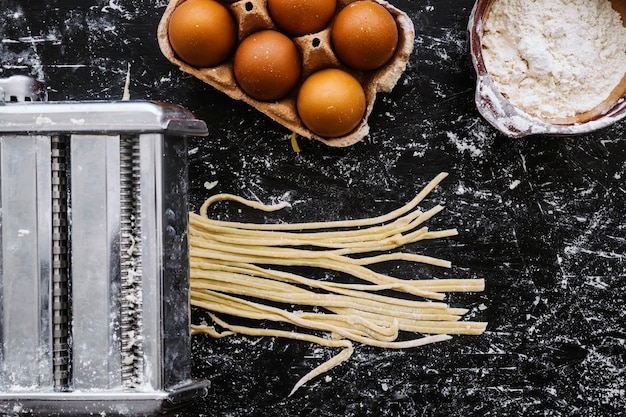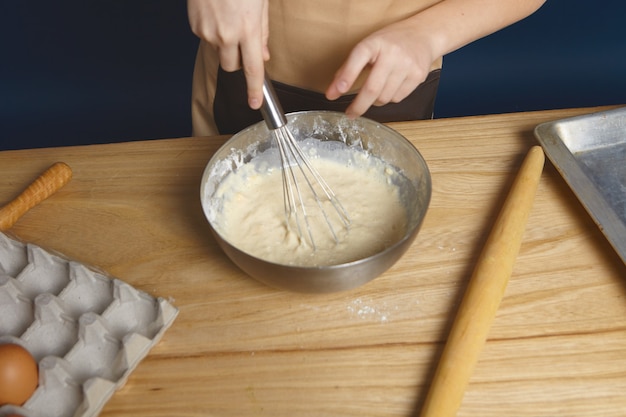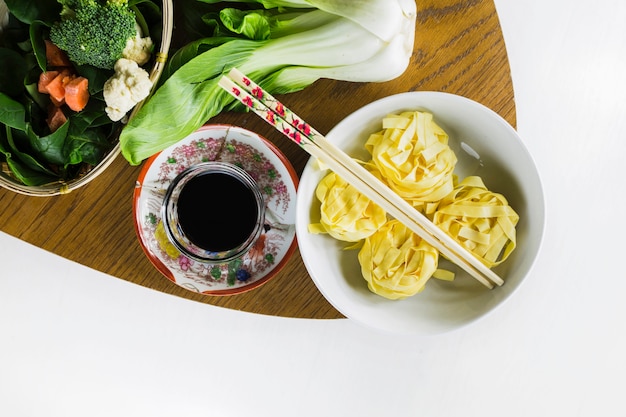Let me tell you, mastering the art of cooking egg noodles is like finding the perfect cuppa – it takes a bit of experimentation and patience, but once you nail it, you've got a recipe for pure bliss. I've been there, you know, the soggy, overcooked noodles that make you wonder if you should just order takeout. But don't you worry, I'm here to share my journey and help you avoid those noodle disasters!
This article is your ultimate guide to egg noodle perfection. We'll be covering everything from choosing the right noodles to understanding the nuances of different cooking methods, and of course, we'll delve into the art of getting that perfect al dente texture. So grab your favourite saucepan, a trusty timer, and get ready to embark on this culinary adventure!
(Part 1) Finding Your Perfect Noodles

Choosing Your Weapon: The Noodles
First things first, let's talk noodles. You wouldn't use the same paintbrush for landscapes and portraits, right? The same goes for noodles! Choosing the right type can make a world of difference. I've got a few favourites that always deliver:
Classic Egg Noodles: These are my go-to for a simple, hearty dish. They're versatile, hold their shape well, and soak up sauces beautifully. Think creamy carbonara or a comforting chicken noodle soup.
Fettuccine: This wide, flat noodle is fantastic for twirling up with sauces like pesto or a rich ragu. It's also a great base for a baked pasta dish.
Linguine: A bit thinner and longer than fettuccine, linguine is ideal for lighter sauces and seafood dishes. The shape allows for the sauce to cling to the noodles perfectly.
Spaghetti: The classic long, round noodle, spaghetti is a staple for many pasta dishes, from simple tomato sauce to elaborate meat sauces. It's best served with chunky sauces that cling to its surface.
Angel Hair Pasta: This incredibly thin noodle is ideal for delicate sauces and light dishes. Its delicate texture melts in your mouth and is best served with light sauces or butter.
Reading the Label: What to Look For
Noodle packages are a treasure trove of information, so make sure you're reading the fine print. Here's what to watch out for:
Freshness: Always opt for noodles with a recent production date, especially if you're buying them from the supermarket. You want them to be as fresh as possible for the best texture and flavour. Stale noodles tend to be drier and less flavorful.
Ingredients: Pay attention to the ingredients list. Some brands might add things like starch or preservatives, which can affect the taste and texture. Stick to simple, straightforward ingredient lists for a better experience. You want your noodles to be made primarily with flour, eggs, and water.
cooking time: The package usually provides a recommended cooking time. This is a good starting point, but remember, everyone's stove and preferences are different, so always adjust accordingly. The cooking time is a guideline, not a rule.
(Part 2) The Art of Boiling Water

The Big Pot: How Much Water is Enough?
You might be tempted to throw a handful of noodles into a small saucepan, but resist the urge! You need enough water for the noodles to swim freely. The general rule of thumb is to use at least 6-8 cups of water for every pound of noodles. Trust me, this will prevent the water from getting starchy and ensure even cooking. The noodles need room to move around and cook evenly.
The Big Reveal: Adding Salt to the Water
Now, let's add a dash of flavour! A pinch of salt in the boiling water not only adds flavour to the noodles, but it also helps them cook more evenly. I usually use about 1 tablespoon of salt per 6-8 cups of water, but feel free to adjust to your liking. The salt helps to season the noodles and prevents them from becoming bland.
The Boiling Point: Bringing the Water to a Rolling Boil
Once the water is in the pot, turn the heat up to high and bring it to a full rolling boil. You want to see those bubbles vigorously bubbling and churning, creating a swirling vortex of culinary magic! This ensures that the noodles will cook evenly and quickly. The boiling water provides the necessary heat for the noodles to cook through.
(Part 3) Noodle Immersion: The Plunge

The Gentle Drop: Adding the Noodles
Once your water is at a rolling boil, gently drop your noodles into the pot. Don't just chuck them in like you're tossing a grenade! A gentle drop will prevent the water from cooling down too much. The sudden change in temperature can make the water stop boiling, so be gentle.
The Stirring Dance: Keeping Things Moving
As soon as the noodles are in the water, give them a good stir with a wooden spoon or a spatula. This will prevent them from sticking together and ensure they cook evenly. Think of it as a little noodle dance to prevent clumping. This is especially important when dealing with pasta with a thick sauce.
(Part 4) The Clock is Ticking: Cooking Time
Timing is Everything: Checking the Package
Now, it's time to consult your trusty package for the recommended cooking time. This is just a guideline, so don't be afraid to adjust as needed. The cooking time will depend on the type and thickness of the noodles, so keep an eye on them. Remember that the recommended time is just a starting point.
The Al Dente Test: The Perfect Bite
The ultimate test for perfect noodles is the al dente test. This means that the noodles should be cooked through but still have a slight firmness to the bite. You want them to have that springy, "bounce back" feeling. If they're too soft, they're overcooked. The al dente test ensures that the noodles are cooked but still have a pleasant texture.
Adjusting the Timing: Going Beyond the Guidelines
Don't be afraid to experiment! If you prefer your noodles a bit softer, add a couple of minutes to the cooking time. If you like them with a little more bite, remove them a minute or two earlier. It's all about finding your sweet spot! Every noodle lover has their own personal preference for texture.
(Part 5) The Drain: Letting Go
The Strainer: Your Noodle Rescuer
Once your noodles are cooked to perfection, it's time to drain them. Using a large strainer, gently scoop the noodles out of the boiling water and transfer them to a clean bowl or colander. Make sure the strainer has enough room for the noodles to drain without getting stuck! Choose a strainer that is large enough to hold all the noodles comfortably.
The Cold Plunge: Cooling Down the Action
For a smoother, more manageable texture, you can give your noodles a quick cold plunge. After draining, run cold water over them for a few seconds. This will stop the cooking process and help to prevent the noodles from sticking together. A cold water rinse can prevent the noodles from continuing to cook and becoming mushy.
(Part 6) The Finishing Touches: Adding Flavor
The Sauce: Bringing Out the Best
Now comes the fun part! The sauce is what truly elevates your noodle dish. Whether it's a creamy Alfredo, a vibrant pesto, or a hearty tomato sauce, make sure your sauce is hot and ready to mingle with the noodles. The sauce is the perfect compliment to the noodles and adds a burst of flavor.
The Toss: A Culinary Union
Gently toss your noodles with the sauce until they are well-coated. This is your chance to create a symphony of flavours! You want to ensure that every noodle gets a generous helping of that delicious sauce. The tossing process helps to distribute the sauce evenly and ensures that the flavors meld together.
(Part 7) Presentation: A Feast for the Eyes
The Plating: A Touch of Finesse
Once your noodles are sauced to perfection, it's time to plate them up. Think about the visual appeal. A little bit of creativity can go a long way. You can use a spoon to create swirls in the sauce, or arrange the noodles in a fan shape. The presentation of your dish can enhance the dining experience.
The Garnish: A Final Flourish
A sprinkle of fresh herbs, a dollop of sour cream, or a few toasted pine nuts can add the finishing touch to your noodle dish. It's the little details that elevate your culinary masterpiece! Garnishes are the finishing touch that can add a pop of color and texture to the dish.
(Part 8) Storing Leftovers: A Noodle Revival
Refrigeration: Keeping Things Fresh
If you have leftover noodles, store them in an airtight container in the refrigerator. They'll keep for 3-4 days. However, the texture might change a bit after refrigeration. Storing leftovers properly ensures that they stay fresh and prevent them from becoming stale.
Reheating: Bringing Back the Bite
When you're ready to enjoy your leftover noodles, gently reheat them in a skillet with a little bit of olive oil or water. You can also add a bit of extra sauce to revive the flavours. You can also reheat them in the microwave, but the texture might change slightly.
FAQs
1. What if my noodles are sticking together?
If your noodles are sticking together, it's likely because they haven't been cooked in enough water, or they haven't been stirred enough. You can try rinsing them in cold water, then tossing them with a little oil to help separate them. This will prevent the noodles from sticking to each other.
2. Can I use any type of noodles for any dish?
While you can use any type of noodle for any dish, some pairings work better than others. For example, spaghetti is a classic choice for marinara sauce, while angel hair pasta is better suited for lighter sauces. The thickness and shape of the noodle can affect how it interacts with the sauce.
3. What if my noodles are overcooked?
If your noodles are overcooked, they'll be mushy and have lost their shape. Sadly, there's not much you can do to salvage them. Try using them in a soup or a casserole, where the texture won't be as noticeable. You can still use overcooked noodles, but they may not be ideal for dishes that require a firm texture.
4. Can I cook noodles ahead of time?
Yes, you can cook noodles ahead of time. Just be sure to rinse them in cold water to stop the cooking process and prevent them from sticking together. You can then store them in the refrigerator for up to 3-4 days. Cooking noodles in advance can be helpful for meal prepping or busy weeknights.
5. Is it better to cook noodles in a big pot or a small pot?
It's always best to cook noodles in a large pot with plenty of water. This helps prevent the noodles from sticking together and ensures even cooking. The water also won't get overly starchy, which can make the noodles gummy. A large pot allows for the noodles to cook evenly and prevents the water from becoming starchy.
I hope this guide has been helpful! Now, go forth and conquer the world of egg noodles! Remember, practice makes perfect, and don't be afraid to experiment. Soon, you'll be a noodle master, whipping up delicious dishes that will impress even the most discerning of palates. Happy cooking!
Everyone is watching

Perfect Rice Every Time: The Ultimate Guide to Cooking Rice
Cooking TipsAs a self-proclaimed foodie, I've always been a bit obsessed with rice. It's the foundation of countless cuisi...

Prime Rib Roast Cooking Time Chart: Per Pound Guide
Cooking TipsPrime rib roast. Just the name conjures images of lavish dinners, crackling fires, and hearty laughter. It’s ...

The Ultimate Guide to Cooking Asparagus: Tips, Techniques, and Recipes
Cooking TipsAsparagus. The mere mention of this spring delicacy conjures up images of vibrant green spears, crisp and burs...

Ultimate Guide to Cooking the Perfect Thanksgiving Turkey
Cooking TipsThanksgiving. Just the word conjures up images of overflowing tables laden with delicious food, the scent of r...

How Long to Bake Potatoes in the Oven (Perfect Every Time)
Cooking TipsBaked potatoes are a staple in my kitchen. They're incredibly versatile, delicious, and surprisingly easy to m...
